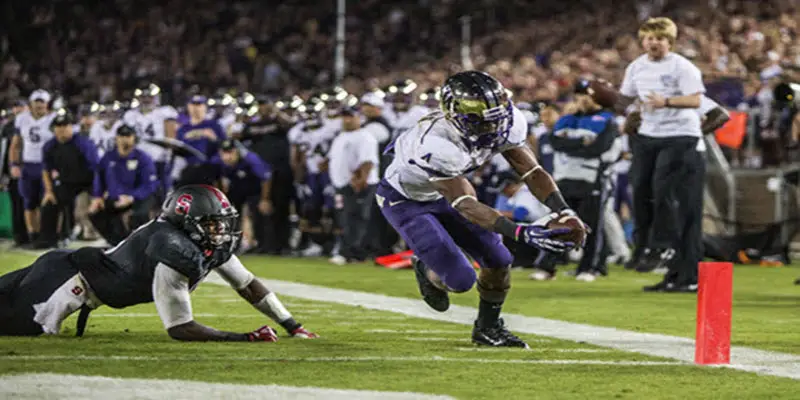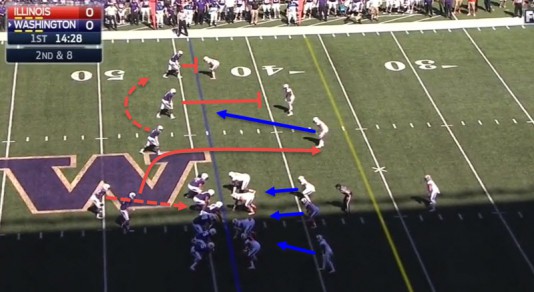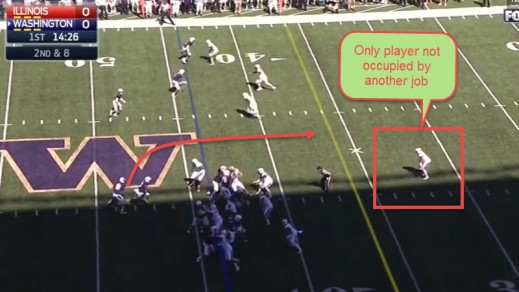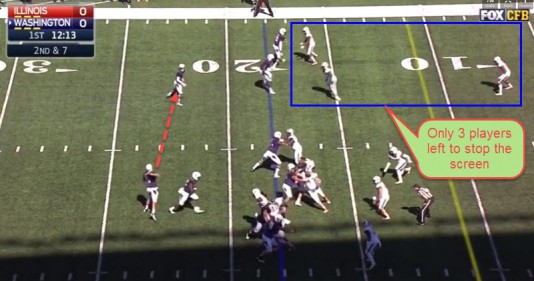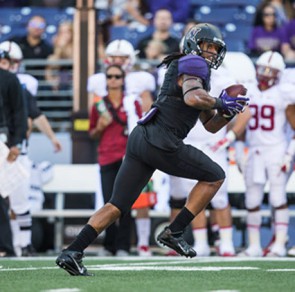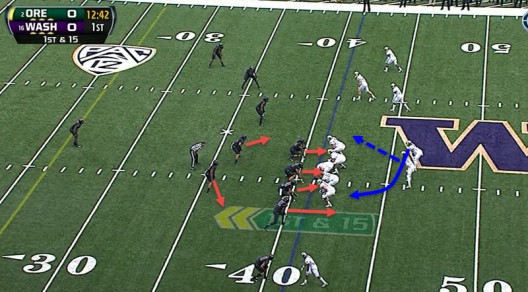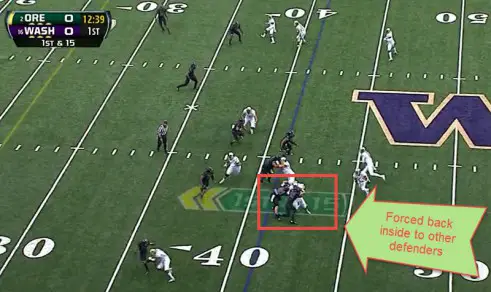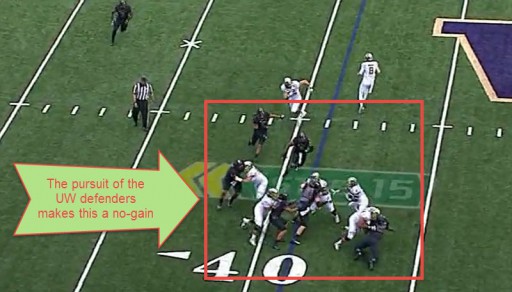Last year, a friend of mine who is a diehard Oregon fan showed me an email that his dad had sent to a few Oregon alumni. The email was about three pages long, and was an in-depth history of the Oregon-Washington rivalry. Being a Stanford fan at the time, I hadn’t really known exactly how much hostility existed between Oregon the Huskies. Now, as a growing Oregon fan who has read the aforementioned email, I am beginning to understand this rivalry.
Now, once again, we are coming up against a high-octane, speedy, and shifty offense. Excluding Oregon because of my bias, I think Washington is the most elusive team in the conference. Their combo of veteran Jaydon Mickens and upstart receiver John Ross could easily be one of the deadliest pairs Oregon will face.
And that’s without mentioning Cyler Miles, the sophomore quarterback. Despite not being named the starter until after week one, Miles has made his name known to Pac-12 fans.
The two plays I am going to show you are identical in nearly every respect, except that one is a read option, and the other is a bubble screen. As you can see above, this formation is strong right, meaning the majority of the players are on the left side of the center and quarterback.
This is an optimal formation to run the inside zone read, as the receivers are spreading the field and the running back is lined up behind the quarterback. To no one’s surprise, Washington is going to run the zone read, with the right defensive end being the “read player.”
At the snap, the offensive line is going to run a man-blocking scheme, with the left tackle sealing the right defensive tackle in order to keep him from having the chance to make a play — if the quarterback keeps it on the read. In this case, the quarterback is going to keep the ball, as the right defensive end goes after the running back.
The key part of the play is the route run by the inside receiver. The inside receiver (above) is going to run a bubble screen, where he takes a few steps to his left and looks for the ball while the other receivers are blocking.
This route draws the strong safety away from where the quarterback is running, because he has to respect the screen, leaving only the free safety available to make the tackle on the quarterback.
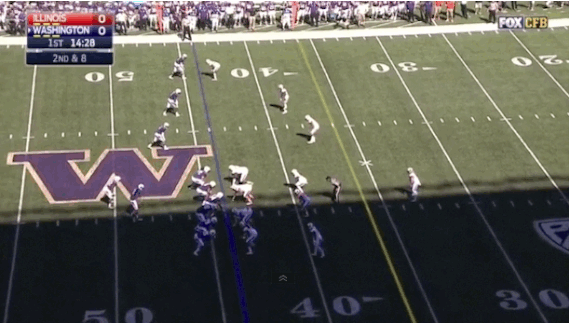
A good zone read …
This is where new Husky coach, Chris Petersen, shows why he was such a coveted leader over the past few years. Just a few plays later on the same drive, the team lines up in the same exact formation (above), except the tight end is now on the left side of the line instead of the right. The defense lines up in the same formation as well.
This potentially sets up the Huskies for huge success. The defense has a tough decision to make — just a minute ago they saw the Huskies run the ball out of this formation … so do they now focus on the run or pass? To add to the defense’s conundrum, the player that has the chance to get the ball on the bubble screen is Jaydon Mickens, one of the best receivers after the catch in the Pac-12.
When the ball is snapped, the running back and quarterback (above) fake like they are running the zone read, but the quarterback is pulls it. The linebackers have to respect the run, so they step in and go after the running back, while the quarterback has the ball instead. This leaves only three defenders to stop the pass, each one-on-one with the receivers.
The inside receiver, Mickens, runs a bubble screen and the quarterback, this time, throws the ball to Mickens. Now, with the help of the receivers blocking in front of him, Mickens only has the strong safety to beat, who is seven to 10 yards off the line of scrimmage.
A one-on-one with Mickens is not fair for even the best of tacklers; he is too elusive. Mickens wins this battle nearly every time.
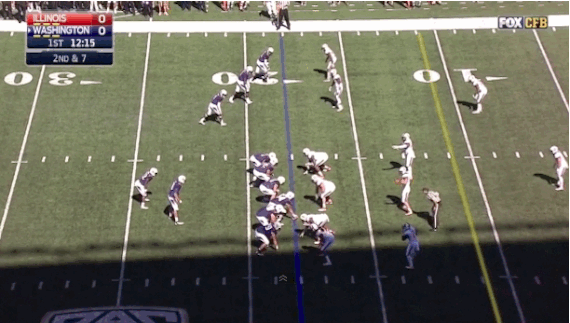
Watch for the bubble!
Now, I didn’t have time to watch every hour of Washington film, but I did notice a trend. It seemed as though Washington ran the bubble screen whenever the strong safety was playing further than six yards off the line, or whenever the two corners covering the two outermost receivers were playing press coverage.
This is probably because when the strong safety is farther off the line, it takes him longer to come up and make the tackle. Also, when the corners are playing press it means that the receivers can immediately start blocking them … instead of letting them see that the play is a bubble screen, which gives them a better chance to avoid the block.
I know that this information may have been a lot to take in, but if you understand it, then you already know much more than your average fan, and Duck fans are not your average fans!
The Huskies’ best player is Shaq Thompson, a linebacker and almost assured first round pick in next spring’s NFL draft. He is a highly versatile player, as he has played safety, linebacker and running back all at the college level. Also, let’s not forget his explosiveness … .
Thompson is the equivalent of De’Anthony Thomas on defense. Whenever the ball comes near Thompson, there is a good chance it will go the other way, and sometimes even end up as six points for the defense.
Thompson already has a rushing touchdown, an interception return for a touchdown and a fumble recovery for touchdown this year. This was all by the end of the third game, and he has since tacked on two more “scoop and scores,” including a 100-yard fumble recovery for touchdown last week against Cal. That’s unprecedented.
So now that I’ve told you about Shaq Thompson, I can tell you about how the Huskies may try to stop our Feathered Friends.
Let’s take a look at a play from last year’s game. The Huskies will most often come out in a 3-3-5 formation with one of the linebackers blitzing off the edge, as you can see above.
At the snap, the left defensive end (the defensive player being read in this zone read play), takes the quarterback. The left outside linebacker also stays and takes the quarterback, to force the quarterback to hand it off (above). Then, the two rightmost defenders on the line push far upfield to force the running back inside, to where the nose tackle and middle linebacker are.
The result is optimally a gain of no more than two to three yards. Against the Ducks’ offense, gains of only three yards are exactly what the defense is hoping to get for every play. The key to beating the Ducks is slowing down the game and forcing the offense to make slow and methodical drives instead of short drives with explosive plays.
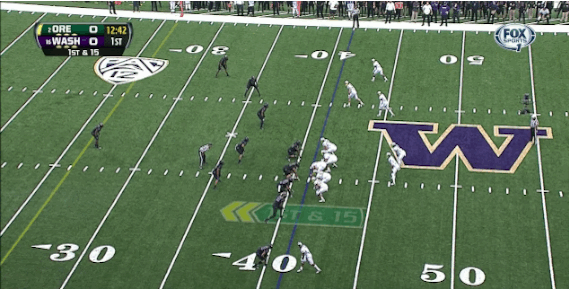
Washington has a defense this year …
It’s the 20th anniversary of “The Pick” and even though I don’t yet have the built-in antipathy toward UW as some Duck fans, I do know this game can hold significance for its viewers.
As such, I will say that Oregon’s battered offensive line is going to show up for this game against a very strong front seven, and Oregon should end up pulling away for a big-time win. I predict the score to be 38-24, Oregon.
“Oh, how we love to learn about our opponents on FishDuck.com.”
Rory Davidson
Opponent Football Analyst for CFFNetwork/FishDuck.com
Eugene, Oregon
Top photo by Dean Rutz
Related Articles:
Chip Kelly Update: Everything's Good Again ...
Chip Kelly Update: Wailing and Gnashing of Teeth
Shock and Awe -- The Oregon Ducks' Football Hangover Effect
Despite Lopsided Score, Georgia State "Never Stopped Believing"
Hope Springs Eternal for Ducks
Incompetent Pac-12 Officials: How Do You Miss ALL of THIS?
Rory Davidson: Rory (Football Analyst) is a sophomore at Oregon in the fall (Class of 2018). He has been a devout Stanford football fan since he was 2 months old and is excited about the energy and greatness Oregon sports has to offer. For the past 6 years he has been doing advanced data analytics for his high school football team and working alongside the coaches to understand how they strategize about the game. He wants to integrate more statistics into his analyses and try to help readers learn about and understand the future of sports.

